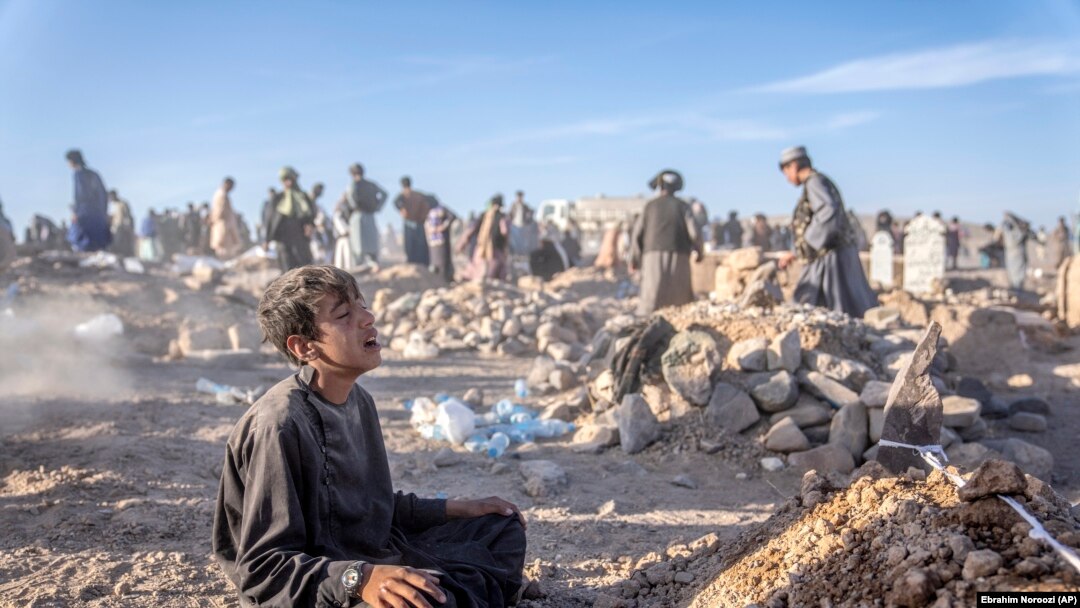At least one person was killed and 152 were injured by a fresh 6.3-magnitude earthquake in western Afghanistan on early October 11, days after a series of quakes at the weekend that reportedly killed at least 2,000 people.
The U.S. Geological Survey (USGS) said the latest magnitude 6.3-earthquake occurred some 28 kilometers outside Herat, the capital of the province by the same name.
Nisar Ahmad, spokesman for the governor of the province, said a number of villages had been destroyed and there was an unspecified number of injured people. He did not say anything about the number of deaths, but the Taliban-controlled Bakhtar news agency reported that one person died and 152 others were injured, citing local health officials.
Ahmadullah Muttaqi, director of information and culture for the Taliban-led government for Herat Province and the head of the earthquake relief commission, confirmed in an interview with RFE/RL's Radio Azadi that 120 people has been injured, but said this was a preliminary figure.
Muttaqi also said that the number of victims in the latest earthquake was low because many people have not returned to their homes since the previous earthquake.
The aid group Doctors Without Borders said the Herat regional hospital received nearly 120 injured from the latest temblor. The group, also known by its French acronym MSF, said it sent additional medical supplies to the hospital and was setting up four more medical tents at the facility.
“Our teams are assisting in triaging emergency cases and managing stabilized patients admitted in the medical tents,” MSF said on X, formerly known as Twitter.
The AFP news agency reported that patients were being treated in an outdoor courtyard at Herat Regional Hospital.
WATCH: Another strong earthquake shook western Afghanistan on October 11, just four days after a major temblor that claimed nearly 3,000 lives, according to Taliban officials.
Your browser doesn’t support HTML5
Strong New Quake Rattles Western Afghanistan
Ambulances were being sent to Herat's Rabat Sangi district, which reportedly bore the brunt of the latest earthquake.
According to the AP news agency, the new quake destroyed some 700 homes in Chahak village, which had not been affected by the tremors of previous days.
No deaths have been reported so far in Chahak as people have taken shelter in tents this week, fearing for their lives as tremors continue to rock Herat, the AP also reported.
No further details were immediately available.
The epicenter of the first earthquake on October 7 was some 40 kilometers northwest of Herat, which has 700,000 people in the city and the surrounding area. It was followed by at least three major aftershocks.
The USGS recorded the largest of the temblors at a magnitude of 6.3, with the latest aftershock coming about 30 kilometers northeast of the city of Zindah Jan, which has a population of about 70,000 people.
Taliban officials said at least 2,000 people were killed in the weekend earthquakes, but did not come up with a final official figure.
On October 11, the Taliban Public Health Minister Qalandar Ebad lowered the toll to around 1,000.
"We have over 1,000 people martyred from the first incident," Ebad told reporters in Kabul.
The World Health Organization has put the total number of people affected at more than 11,000.
Earthquakes are common in Afghanistan, where there are a number of fault lines and frequent movement among three nearby tectonic plates.
Afghans are still reeling from recent quakes, including the magnitude 6.5-earthquake in March that struck much of western Pakistan and eastern Afghanistan, and an earthquake that hit eastern Afghanistan in June 2022, flattening stone and mud-brick homes and killing at least 1,000 people.
Afghanistan is already suffering a dire humanitarian crisis, with the widespread withdrawal of foreign aid following the Taliban’s ousting the Western-backed Afghan government and taking over the country in August 2021.
Herat Province, on the border with Iran, is home to around 1.9 million people, and its rural communities have been suffering from a yearslong drought.


